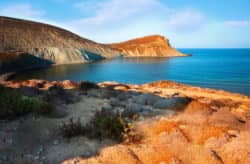About Lemnos, Greece
Lemnos is an island in the Aegean Sea. The island of Lemnos is mostly flat except for the northwestern part, which is mountainous and rough. The  highest point on the island is Mount Skopia at 430 meters. The island has a strong tradition of husbandry. The hillsides make good pastures or sheep. Lemnos is also well-known or its kalathaki limnou, a type of cheese made from sheep and goats milk. They also make melipasto cheese and yogurt. Fruits and vegetables also grow on the island including: olives, pumpkins, tomatoes, watermelons and other melons, figs, and almonds. The crops that grow on the island of Lemnos include: barley, sesame, and wheat. After the Byzantine Empire lost its Anatolian possessions in the 1320s, Lemnos would become Constantinople’s granary. Lemnos also produces honey from thyme-fed bees, but this product is mainly or local market. Muscat grapes are grown on the island of Lemnos and these are used to produce a unique table wine that features a strong Muscat flavour.
highest point on the island is Mount Skopia at 430 meters. The island has a strong tradition of husbandry. The hillsides make good pastures or sheep. Lemnos is also well-known or its kalathaki limnou, a type of cheese made from sheep and goats milk. They also make melipasto cheese and yogurt. Fruits and vegetables also grow on the island including: olives, pumpkins, tomatoes, watermelons and other melons, figs, and almonds. The crops that grow on the island of Lemnos include: barley, sesame, and wheat. After the Byzantine Empire lost its Anatolian possessions in the 1320s, Lemnos would become Constantinople’s granary. Lemnos also produces honey from thyme-fed bees, but this product is mainly or local market. Muscat grapes are grown on the island of Lemnos and these are used to produce a unique table wine that features a strong Muscat flavour.
The earliest inhabitants of the island of Lemnos are said to have been a Thracian tribe the Greeks called Sintians, which means “robbers.” Hecataeus, an early Greek historian, said that the name Lemnos had been given to Cybele by the Thracians. Cybele was an Anatolian mother goddess. The worship of Cybele was characteristic of Thrace.
The island of Lemnos has provided much evidence about its history. A large number of coins from Hephaestia were found. There were a variety of designs on them including: Athena with her owl, the caps of Apollo and Dioscuri, native religious symbols, and more. Other coins have been found, such as those from Myrina, but in lesser numbers. A few coins bear the name of the island while others bear the name of one of two cities: Myrina and Hephaestia. An inscription on a funerary stele from the 6th century was found with Lemnian language. The island of Lemnos would eventually adopt the Attic dialect of Athens.
Administrative Region of Lemnos Island, Greece
North Aegean
Area of Lemnos Island, Greece
477.6 km2 (184.4 sq mi)
Population of Lemnos Island, Greece
16,992
Top Attractions in Lemnos Island, Greece
Church of Panagia Kakaviotissa – Located in the countryside close to Thanos. The chapel is located inside a rock cavity. The church was founded in 1416 AD, by monks who escaped the Turkish invasion of Agios Efstratios Island.
Ancient Poliochni – This archaeological site is 30 km east of Lemnos Town. The ancient city of Poliochni is thought to be the oldest settlement in Europe. The oldest settlement on the site is thought to date back to 4000 BC.
Byzantine Castle – The Byzantine Castle of Myrina stands on a hill overlooking the town. During Ottoman rule, the Turks lived inside the castle and the remains of the mosque can still be seen. The area is home to many deer, which the locals take care of.
Thanos Beach – 4 km south of Myrina. This is one of four Blue Flag beaches on the island. The area is surrounded by volcanic rock and the beach has fine sand and azure colored water.
Zematas Beach – 40 km northeast of Myrina. This beach gets windy, making it the perfect spot for water sports like windsurfing. There are fish taverns close to the beach.
Temple of Kavirio – Located in Kondopouli. The temple dates from the 7th century BC. The site was found and excavated in 1937, unearthing an initiation hall, palace, and arcade as well as 12 Doric columns.
Church of Agios Nikolaos – Located in Myrina. This church sits on a hill overlooking the port and town. The unique architecture and size make it worth seeing.
Aliki Lake – Located in Kondopouli. Aliki Lake is a coastal marsh that covers approximately 1600 acres. If you’re a nature lover, you’ll want to come to explore the area and spot different wildlife.
Myrina Beach – Within walking distance from the city center and the harbour. The beach is family friendly with seaside cafés and taverns close by. The beach has both sandy parts and pebbled parts.
Keros Beach – 32 km northeast of Myrina. Keros is a large beach that has ideal conditions for windsurfing and other water sports. The sand is soft and the beach is partly organized.

